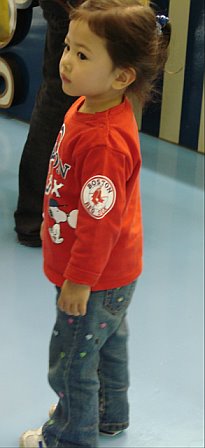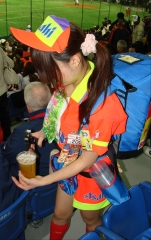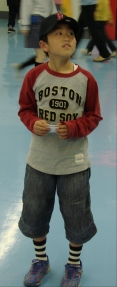 Final reflections from Japan as I wait for the bus to the airport:
Final reflections from Japan as I wait for the bus to the airport:
An Important Call From Home
Calls from the U.S. to Tokyo are expensive, so when I received a call from my wife on Tuesday morning (Monday night in the U.S., several hours after the Sox’ opening day victory), I knew it had to be about something important. “Your son wants to talk with you,” she said. Then my almost-nine year-old got on the phone. “Daddy, guess what, Manny Ramirez got me 8 points for my fantasy baseball team last night, and I’m in first place!”
OK, who wants to bet with me about who’s going to have more fun playing Fantasy Baseball this year?? (That was a priceless phone call.)
 Wally Yonamine: The First Japanese Player to Hurry
Wally Yonamine: The First Japanese Player to Hurry
This morning, I read that the first American born man to play in Japan (Wally Yonamine, Central League MVP in 1957, born in Hawaii) was the first professional player to sprint from home to first on ground balls (before him, Japanese pros jogged or walked – could Manny Ramirez possess the soul of an ancient Japanese baseball player?) and the first to break up double plays by sliding hard into second base. That helps explain why no one is ever in a hurry here in Japan.
I mean, I felt no need to wear my seatbelt in the taxis I rode in. You just have to trust me when I tell you that Tokyo drivers are the safest on the planet. No one’s driving is even remotely aggressive. This was a problem when I was in a rush to get to the Tokyo Dome to film some interviews with Japanese fans for NESN. In Boston, my half-hour trip would have been cut down to 10 minutes (at the expense of the safety of other drivers on the road). Drivers here are actually cooperative, as if the people in the cars around them are members of their family or close friends. (Let me be clear: I think this is awesome.)
 Interviews with Japanese Baseball Fans
Interviews with Japanese Baseball Fans
Before the second game of the Sox-A’s series, I had a chance to interview Japanese fans through an interpreter. Their answers to my questions were truly illuminating. First of all, three different people said, “Please take good care of Matsuzaka and Okajima” in response to my question, “Is there anything you want to tell the baseball fans back in the U.S.A?” Secondly, in response to my question, “What do you think of the U.S. fans who are here at Tokyo Dome?” all six of the fans I interviewed said, “We are grateful to the U.S. fans for coming here and showing their teams so much support.” Grateful is the key word. Several of the fans with whom I spoke said that their favorite Red Sox players were people other than Matsuzaka and Okajima (with Ramirez and Ortiz leading in popularity).
Ladies and gentlemen, not only is the world flat, as Thomas Freedman’s book title declares, Red Sox Nation is flat. Although I don’t have a specific quotation to prove it, it’s obvious to all U.S. fans here that the Red Sox fans at Tokyo dome are true fans of the Red Sox, not just fans of their country’s stars playing in the Major Leagues. They talked about the history of the Red Sox, they talked about Fenway Park, and they talked about current players as knowledgably as a Boston fan would. “Manny’s my favorite player because he’s so goofy and relaxed, and a great hitter,” said one young fan wearing a Ramirez t-shirt. “I became a fan of the Red Sox because of Nomar Garciaparra” said another fan. “I love his style of play.”
One fan who believes my powers as VP of RSN are supreme bent my ear for five minutes, expressing her frustration that “the Yankees and Mariners games are all televised in Japan because Matsui and Ichiro are everyday players, but Red Sox games are only televised when Matsuzaka pitches. Can you change that?” She also let me know that MLB-TV doesn’t work in Japan. “All of Japan is a blackout area,” she said indignantly.
 Q&A With Ramirez, Remy, and Friends
Q&A With Ramirez, Remy, and Friends
The Red Sox hosted a luncheon for Red Sox fans in Tokyo on Wednesday, and after lunch we were surprised with special guests J.D. Drew, Alex Cora, Manny Delcarmen, Manny Ramirez, President Jerry Remy, and Don Orsillo. Obviously, Ramirez’s presence was electrifying. After they all signed autographs, there was time for a Q&A. Here are the highlights:
One fan asked all of them, “What’s surprised you most about being in Japan?” and Alex Cora immediately responded, “That Manny [Ramirez] made it here.” (laughter) “And by the way, his grandmother’s doing fine.”
Ramirez was asked who he considers to be the toughest pitcher to face in baseball, or which pitcher he fears the most. Manny thought for about five seconds, then responded jovially, “I’m ready. Nobody’s tough for me. I’m ready.”
One fan asked Don Orsillo to name the announcers who have been his biggest inspirations. He responded immediately, “Ken Coleman and Vin Scully.”
A fan asked Jerry Remy if, when he was a player, he ever thought he’d be a baseball TV announcer. “No, because I couldn’t put a sentence together then, and I still can’t.” (laughter) “I really have no idea how this happened!” Then Ramirez added, “When we all saw him playing, we knew he’d be an announcer.”
One fan asked Ramirez if he could please let us know which exact date he expects to hit is 500th home run. “Hey, my goal is to reach 500 this month.” (He currently has 492 career home runs.)
J.D. Drew was asked why the Red Sox don’t run more. “Well, we don’t have a lot of speed. (laughter) And I think we all saw how fast Manny is yesterday.” (laughter – Manny stood at home plate to admire his game-winning double before beginning to run, and was almost out sliding into second.)
When Ramirez was asked to make a prediction for this season, he said, “Man, I’m gonna lead the league in RBIs. AGAIN. (laughter) And we’re gonna repeat, we’re gonna do it again. We’re a DYNASTY.”
 Japan’s Social Culture is Highly Advanced
Japan’s Social Culture is Highly Advanced
A Red Sox fan asked me this morning, “What’s been the most memorable moment of the trip for you?” My answer was, “Brandon Moss’s game-tying homerun (9th inning of Opening Day victory) and shaking Manny Ramirez’s hand.”
But I know that the more enduring memories of my trip to Tokyo will be about the people here and the stunningly advanced social culture of cooperation and respect for others. As one Japanese fan said to me in an interview, “We have learned a lot from American baseball players, but we think American players can learn a lot from how the Japanese play the game, as well.” This is absolutely true (the Japanese are obsessed with fundamentals and practicing), but in terms of what all Americans can learn from Japanese culture, the fan’s comment doesn’t go nearly far enough.





















































